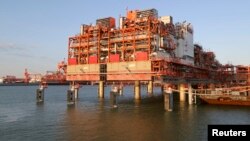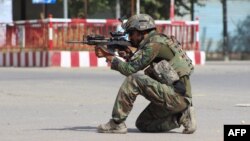
Look at a map showing population density in Central Asia and it is immediately apparent that the majority of the region's approximately 68 million people live in the east.The reason is equally obvious; the western part of Central Asia is home to two large deserts, Kyzyl Kum and Kara Kum -- the red and black sand deserts, respectively.
At the same time, the bulk of the region's substantial hydrocarbon wealth is located in the western half of Central Asia. Efforts to open up the region and bring people in to work these vast oil and natural gas fields have been limited to a significant extent by the inability to provide adequate water to populations in western Kazakhstan and Turkmenistan.
A solution to this equation is there -- the Caspian Sea -- and now officials in Kazakhstan's southwestern Mangistau Province are preparing to harness this resource by building a water purification plant.
The head of the provincial department for industrial-innovation development, Nurbek Karasaev, announced plans for construction of the plant at the end of September. According to Kazakhstan's Kursiv.kz news website, Karasaev said the plant would be located in the Karakiya district of Mangistau Province. Karakiya is the southernmost district of the province. To the west of Karakiya is the Caspian Sea, to the south Turkmenistan, and to the east Uzbekistan. The name Karakiya means "Black Cliff(s)" and provides an excellent idea of what the area looks like.
Mangistau is one of Kazakhstan's major oil-producing regions. Therefore, it is not surprising that a co-sponsor of the water purification plant is KazMunaiGaz [KMG], the state oil and gas company. Technically the co-sponsor is KMG subsidiary OzenMunaiGaz. Karasaev noted the plant was being built "in the first place for the needs of OzenMunaiGaz and for the population, to relieve the shortage of fresh water."
Mangistau Province is not only oil country, it's where two of Kazakhstan's most important Caspian ports are located -- Aktau and Kuryk, the administrative center of the Karakiya district.
Trans-Caspian Pipeline
Kuryk port facilities are currently under construction but the town is to have a new oil terminal for loading tankers. It is also set to be the end point for the Erskene-Kuryk pipeline, which is to bring oil from Kazakhstan's offshore field Kashagan.
There are plans to construct a trans-Caspian oil pipeline that would link the pipeline from Kuryk to Baku, Azerbaijan's capital, on the western shore. Azerbaijan's energy minister just authored an article about it.
The population of Mangistau Province, currently well under 500,000, is nearly certain to see a noticeable increase in coming years as the oil and shipping industries expand, with the accompanying greater demand for water.
I would be remiss not to mention the social situation in Mangistau Province, which is home to Zhanaozen, an oil town that shot to infamy in December 2011 when police opened fire on striking oil workers. At least 16 people were killed.
The drastic fall in oil prices on world markets has caused Kazakhstan to keep production levels in check. With diminished revenues, Kazakhstan's oil companies have been implementing the inevitable reductions in the work force, although with Zhanaozen in mind authorities are moving very slowly. That said, there have been many reports in Kazakhstan that more layoffs are coming soon -- and that oil workers in Mangistau will be affected.
A new source of potable water can't prevent dismissals in Mangistau's oil sector but better social conditions generally have been a frequent demand from people in the region.
New Possibilities
If successful, the water-purification plant could open up new possibilities along the eastern coast of Caspian Sea, in agriculture for example.
Turkmen leaders have spoken about constructing desalinization plants on the Caspian coast for more than a decade but the focus there has remained on internal water-treatment plants and reclamation programs. The country, nearly 90 percent covered by desert, could use a lot more water.
Turkmenistan's Balkan Province borders the Caspian Sea and is a major oil-producing region. But water is available in the provincial capital Balkanabat for only four hours a day.
Playing with water in Central Asia is a very dangerous proposition. It always has been -- even in the much better supplied regions in the east, where the mountains are.
The horribly desiccated Aral Sea is the best-known example of what can happen. The over-planting of cotton and a population almost 10 times larger than it was 100 years ago has left the "Island Sea" little more than alkaline depression in the Kara Kum Desert with water left in only a very small area.
The Karakiya plant would seem to be an answer to these sorts of problems.
PHOTO GALLERY: The Slow Death Of The Aral Sea
In fact, the water level in the Caspian Sea is rising, more than two meters since the late 1970s. The Caspian Sea is fed by some 130 rivers but has no outlet, so water accumulates with only evaporation causing loss.
So an argument could be made that this is, for now, "extra" water that could do much good for coastal areas in Kazakhstan and Turkmenistan if purified.
That process will not be so easy. Water from the Caspian Sea needs to be desalinated.
Back more than 65 million years, the Caspian Sea was the Paratethys Sea and connected the Atlantic, Pacific, and Indian Oceans. Only fresh water flows into the Caspian now but there is still a large amount of residual salt left in the Caspian region.
On the average, water salinity is one-third that in the oceans, but the concentration changes, becoming denser further south in the Caspian. There is one exception, the area around the Kara-Bogaz-Gol; the great shallow gulf off northwestern Turkmenistan where water salinity is ten times that of the ocean.
It also happens to be just south of Kuryk.
Still, the planned purification-desalinization plant in Karakiya district presents few apparent downsides while promising what could be ample reward. In a region that has been short on solutions for a multitude of problems, this is one project that could be key to one of the most basic of needs.









